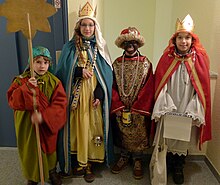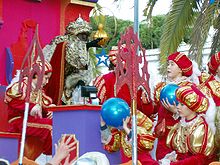
The three holy Kings are also called Wise from the Orient designated. In the Catholic Church they are also used under the name three Kings, venerated as a saint.
The festival celebrated on January 6th is called Epiphany or Epiphany or as Appearance of the Lord designated. In the vernacular there are also the names Epiphany, Epiphany, Epiphany, or as Big New Year, High New Year, Happy New Year or Supreme referred to, in Austria also as Christmas twelve.
Legal holidays
January 6th is a public holiday in Andorra, Finland, Greece, Iceland, Italy, Croatia, Liechtenstein, Austria, Poland, San Marino, Sweden, Slovakia, Spain and Cyprus.
In Germany in the federal states Bavaria, Baden-Wuerttemberg and Saxony-Anhalt, in Switzerland in the cantons Schwyz, Ticino and Uri and in some municipalities in the canton Grisons.
In Georgia Corresponding to January 6 of the Julian calendar, January 19 is the day of Epiphany.
religion
According to Christian tradition, the Three Kings Caspar, Melchior and Balthasar were led to Jesus in the flu by the Star of Bethlehem.
According to the Gospel of Matthew, magicians come from the Orient to worship the newborn King of the Jews.
The Bible tells of the wise men who follow the star and end up in Bethlehem arrive at the stable. There they pay homage to the child and bring gifts, gold, frankincense and myrrh.
regional customs
Epiphany or star singing
In predominantly Catholic parishes in Germany, Austria, Switzerland and South Tyrol there is the tradition of the Epiphany, or carol singing. The carol singers are mostly children and young people who collect donations for charitable purposes or aid campaigns. After singing, write the blessing C M B (Christ mansionem benedicat - Christ bless (this) house) with consecrated chalk and the year on the front doors or the door beam. The three letters also stand for the first letters of the three kings Caspar, Melchior and Balthasar.

Carolers
C M B (Christ mansionem benedicat) and the year
Epiphany Swimming
The Dreikönigsschwimmen is a swim that takes place annually on January 6th in various European waters.
- In Wurzburg there is the 5 km long route in Randersacker, or the 2.5 km long route at Graf-Luckner-Weiher to the Löwenbrücke in Würzburg
- At the Lake Maggiore the event takes place in the port of the border village Brissago instead of. A distance of eighty meters has to be covered in the harbor basin.
Germany
- Drinking starch is an old custom in Upper Franconiawhich takes place on the eve of January 6th or on January 6th itself. The "strength" means health and strength for the new year to arm yourself against future adversities. For this reason, a number of breweries offer strong beer, also known as bock beer. In many taverns there are special offers and meals to drink yourself a decent strength.
- In Dinkelsbühl an Epiphany procession takes place. In the solemn procession, small relics of the Three Kings are carried from the Three Kings Chapel on the city wall to the Catholic Minster St. George.
- In Pottenstein the resolution of "Eternal Adoration" is traditionally celebrated in the form of a festival of lights. Almost 1000 fires burn on the rocks around Pottenstein. After the last hour of prayer, when it gets dark at 5 p.m., the final procession through the village begins, during the procession the fires are lit on the slopes around Pottenstein.
Spain
In Spain the three wise men bring gifts on the night of January 5th to 6th. But only if you were good, otherwise there is only black coal. Many children therefore write a letter to the Three Wise Men, the la carta a los Reyes Magos with their wishes.
In most Spanish cities, Epiphany parades take place on the evening of January 5th Cabalgata de Reyes Magos instead of.
Cabalgata in El Puerto de Santa María

Cavalcada dels Reis, Valencia
Cabalgata de Reyes, Calatayud
- The community Santillana del Mar in Cantabria organizes the annual on January 5th Auto Sacramental y Cabalgata de Reyes de Santillana del Mar, the Eucharistic Festival and Parade of the Magi. The citizens re-enact various scenes about the birth of Jesus.
Italy
- The Pesa Vegia, the Epiphany will take place on the night of January 5th to 6th in Bellano at the Lake Como celebrated. The festival traditionally begins with a nativity play. There are only a few parking spaces, you should arrive by ship or use the shuttle service from Dervio.
Poland
Epiphany parades have also been taking place in some Polish cities for a number of years.
The procession of the Magi in Wloclawek

The spectators wear crowns
to eat and drink
Epiphany cake are a traditional holiday pastry that is baked on the feast day of the three kings. The recipes are very different from region to region, but what all three king cakes have in common is that a small object, e.g. a dried bean, an almond, a coin or a small figure in the form of a king or baby is baked in. If you come across this lucky charm in your piece of cake, you are king for this day.
Switzerland
In Switzerland the Epiphany cake made from sweet yeast dough. Dough balls arranged in the shape of flowers are baked and sprinkled with granulated sugar and flaked almonds. Most Swiss do not bake their Epiphany cake themselves, but buy it with a golden paper crown to put on or at the bakery. A small plastic king figure is baked into the three kings cake in the supermarket.
Big three kings cake

Epiphany cake
Epiphany figure in the cake
France
The Galette des Rois served in France and Belgium on January 6th. It is baked either with yeast dough or with puff pastry. It outputs the northern French variant galette feuilletée Puff pastry with marzipan filling, or the colorfully decorated one in the south of France la brioche Yeast dough rings It is customary to make one Fève (dt. big bean) called small (porcelain) figure to bake. Whoever finds the figure in his piece of cake is king for the day and is crowned with a cardboard crown. He chooses a queen who will also put on a crown. Every time the King drinks, all family members must shout Le roi boit (The King drinks). In some families, a piece of cake is set aside for unforeseen visitors, that Poor piece or Love god piece.

Galette des rois

Brioche des Rois
Epiphany figure in the cake
Spain
The Roscon de Reyes (dt. Königskranz) is a traditional yeast cake in the shape of a wreath, which is baked for the festival of the Three Kings. It is served without a filling, but also with whipped cream, or with a truffle filling, or pudding cream or Cabello de ángel (Eng. angel hair), the caramelized fibers of special types of pumpkin. We decorate it with candied fruit.
A porcelain figurine and a dry bean are baked in. If you find the bean in your piece, you have to pay for the cake for everyone. Anyone who is lucky enough to find the porcelain figure will be crowned king.

The simple cake

richly decorated

and roscones de reyes with crowns
Portugal
In Portugal and also in Brazil, the Epiphany cake is made Bolo Rei called. Similar to Spain and southern France, it is made from yeast dough and decorated with candied fruit. However, it is not shaped as a wreath, but as a spherical loaf.

Bolo Rei

Bolo Rei decorated with candied fruits
Greece
In Greece, the Epiphany cake is used Vasilopita (dt. King's bread) called. It is traditionally eaten on January 1st and a coin is baked as a good luck charm.
Vasilopita
The lucky charm in the form of a coin
Mexico
The tradition of Rosca de Reyes (German royal wreath) was adopted by the Spaniards. The yeast dough wreath cake is decorated with candied desert fruits such as dates and figs.
Several porcelain or ceramic figurines are hidden in the cake. Who has to find a porcelain child Tamales (a traditional dish made of Masa corn dough filled with meat and cheese and steamed in plant leaves) for all guests to bake on February 2nd, the Fiesta de la Candelaria (Mariä Candlemas) are eaten together.

Rosca de Reyes

are bigger than in other countries
Are you happy about this find?
United States
In Louisiana, especially in New Orleans French immigrants brought the tradition with them. There is the variant with puff pastry and marzipan filling, French King Cake and the brightly decorated yeast dough ring King Cake.
A small baby figure is baked in as a symbol for the newborn Christ child. Whoever finds it is the king and has to invite you to the next king cake party. The cakes are in the Mardi Gras season or Carneval Season baked from Epiphany to Shrove Tuesday and eaten at king cake parties.
.jpg/220px-Mardi_Gras_King_Cake_(2244894760).jpg)
The king cakes are decorated in bright colors

The colors green, purple and gold stand for justice, loyalty and power

King Cake Party






.JPG/220px-Włocławek-procession_of_three_kings_(2).JPG)

















.jpg/220px-Mardi_Gras_King_Cake_(2244894760).jpg)

